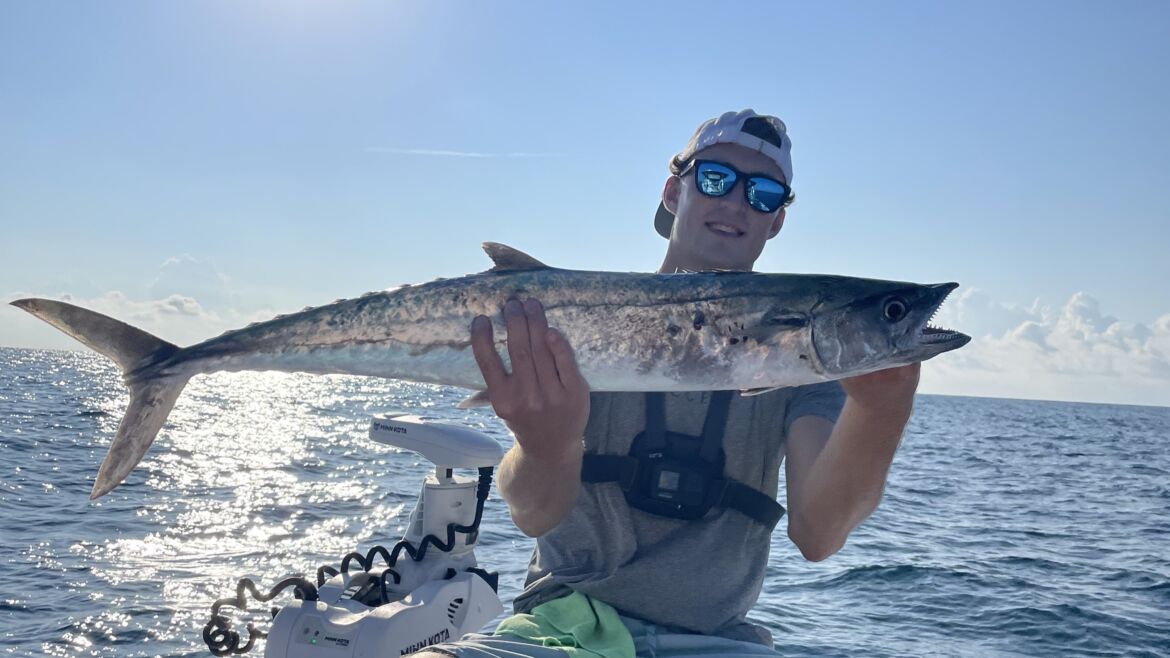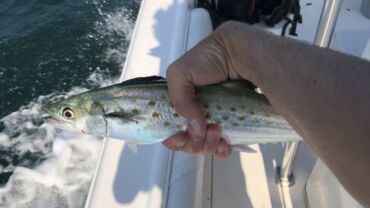King Mackerel are probably one of the most, if not the most, widespread and popular gamefish across the East Coast and even in the Gulf of Mexico. Growing up to 100 pounds, King Mackerel or Kingfish is a prize fish for a variety of anglers around the United States. Because of the huge numbers of Kingfish in the ocean, they make a great fish for commercial fishing, recreational fishing, and even tournament fishing. Having been a part of two of the three (recreational and tournament) I can attest to the value of these fish—especially when it comes to tournaments.
Catch a big enough King Mackerel to win one of the many King Mackerel tournaments on the East Coast and the Gulf and you could very easily be looking at a paycheck of over $100,000. Not only can these fish net good prices for the commercial fishing market and provide monster paychecks to tournament fisherman, but they also are a unit of gamefish. Notorious for huge runs upwards of 300 yards as well as insane acrobatics, you’ll be hard-pressed to find an angler who wouldn’t want to hook up to one of these fish. However, that’s enough of my blabber. You’re here for the tips and tricks of catching more of these amazing fish so let’s get started.
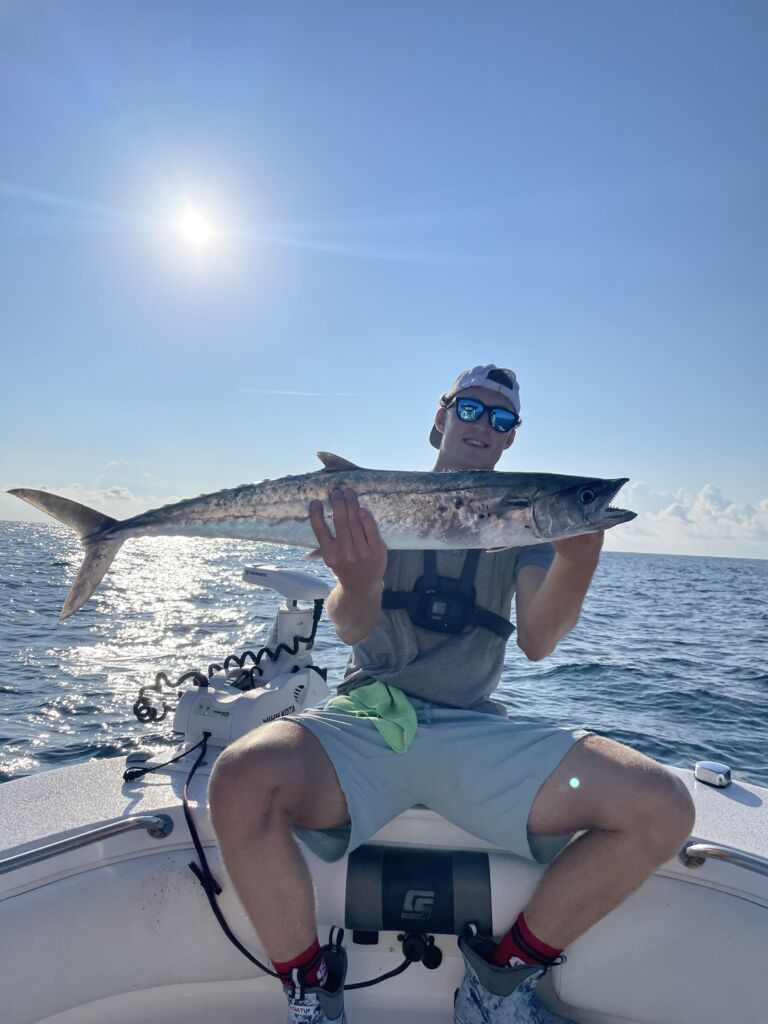
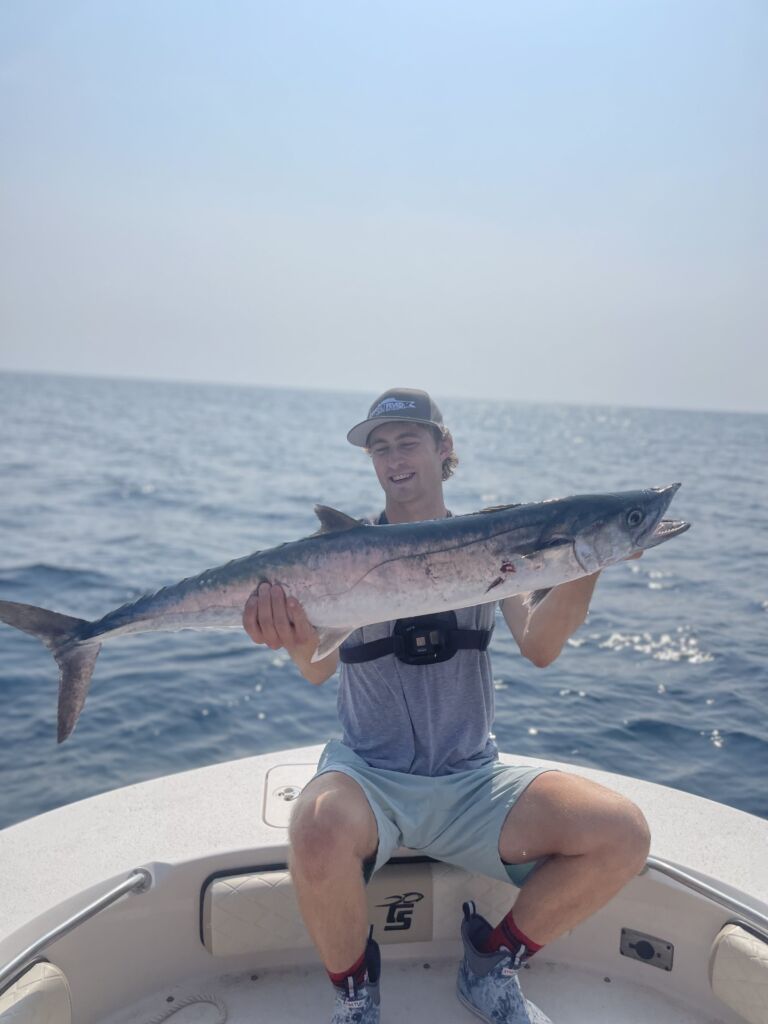
Choosing the Perfect Baits for King Mackerel
The baits for King Mackerel, much like any other type of fish, can be broken down into natural and artificial baits. There are a lot of anglers who have a lot of different opinions on how you should fish for King Mackerel, but I’m going to make this simple for you can give you a few choices and my personal experience to help you decide how you want to tackle these species.
Natural baits:
10 times out 10 I’m choosing natural bait to fish for King Mackerel. Kingfish are notorious for having amazing eyesight so the smartest thing you can do is try to mimic their natural prey by actually using their natural prey as bait. To make this even easier on y’all, I went ahead and broke natural baits down even further into live and dead natural baits.
- Live bait: My personal preference (and most King Mackerel fishermen’s preference as well). With live bait, you get unparalleled action. I can’t stress the power of the Kingfish’s eyesight enough—if something looks just a tad bit off in presentation with dead bait or artificials—they will not bite. Period. Live bait gives you a little bit more wiggle room and I have found it to yield far more results than anything else I have ever been fishing with. Some of these popular live baits include Pogy/Bunker/Menhaden, Pilchards, Blue Runners, Bluefish, Spanish Mackerel, Mullet, and Threadfin Herring. Given a choice between all of these, I’m picking Bluefish for their insane energy and action and Pogies because they tend to produce the best. For now, I’m just going to give you some of the names of these popular live baits and I will go into details about how to rig them later. The important takeaway is this: If you have the opportunity to get live bait, get it. It will produce far more results than any artificial or dead bait.
- Dead bait: I know I just said how great live bait was, but dead bait can also perform very well at times, more importantly, you’re not always going to be able to get live bait. This being said, having an understanding of the different types of dead bait you can use to catch King Mackerel is hugely important. Again, I’m not going to talk about how to rig these baits quite yet, but I will further down in the Tactics section. Anyhow, some of the popular dead baits are Spanish Mackerel, Ribbonfish, Cigar Minnows and Ballyhoo. When rigged correctly, these baits can and will compete with live bait on any given day.
Artificial baits:
Natural baits certainly get a lot of love when it comes to King Mackerel (and rightfully so) but artificial baits, believe it or not, can also prove lethal to King Mackerel. And like I said earlier, while using them is neither mine nor many King Mackerel anglers’ preference, sometimes they have to suffice. After all, being a good angler is all about adaptability and versatility when it comes to strategy—especially about the bait you use. Some popular artificial baits for King Mackerel include Nomad Madscads, Drone Spoons, Clarkspoons, and more.
Hopefully, with this brief discussion of bait you can see the importance of being familiar with all different types. Lucky for you, the Fishbox App provides anglers with the knowledge they need to narrow down their decisions even more based on around 50 metrics related to the bite. Don’t make your bait choice out of random chance, instead download the fishing forecast app today and be more efficient in how you target King Mackerel.
Get your personalized fishing map
Answer a quick quiz and get your own personalized fishing map
Tactics for King Mackerel Fishing
Rigs: Once again, a lot of people will tell you a lot of different preferences for King Mackerel rigs, but there are a few that I’m going to talk about that most King Mackerel fishermen can agree upon and then a couple I like myself. On the live bait side of things, there are three ways you can do it.
The first and most popular is just a wire leader with two size 4 treble hooks about 4-5 inches apart. You start by grabbing any of the live baits listed above (preferably a pogy or bluefish) and put one hook through the nose (on the pogy you need to make sure the hook goes through the clear part of their nose so they don’t die). Then you’ll take the second hook and put it in the back of the bait to where the leader has a little bit of wiggle room so the bait can swim effectively and look normal in the water.
The second option for a rig is almost identical as it is the same rig with a colored skirt in front of the hooks. I have had this work on Kings many times before, but I would still definitely prefer a naked rig if you had frisky live bait, however, if the baits are fairly weak, definitely put a skirt on to spice things up a bit.
The third option is just a wire leader attached to a single circle hook (say a 7/0 or 8/0). Also, it is important to note that some fishermen instead of using two trebles will swap the leading treble with a single circle hook. This single hook gives the bait unparalleled mobility but has a higher chance of pulling when a fish is hooked because there are simply fewer hooks in the fish’s mouth. From my own experience, I like to fish with just a circle hook in the prop wash rod (preferably a spinning rod) so it’s easy to fight with and I can pitch the bait if needed.
On the deadbait side of things, there’s only one way to rig these baits. There are tons of dead bait trolling rigs on the market, but from my own experience and the experience of many seasoned King Mackerel fishermen around me, even ones that have won some of these tournaments, they all stand by the Mac-A-Hoo. Available at most saltwater tackle shops and most certainly online, Mac-A-Hoos has an unparalleled ability to prevent the bait from spinning and keep it below the surface of the water making your bait look as alive as it possibly can. So, if you’re trolling dead baits—use a Mac-A-Hoo.
There’s not too much to talk about regarding artificial baits other than using lures with bills versus planers and lures that don’t have bills. Planers just give your lures added depth so that is something to consider when figuring out your spread.
Gear: I like to use a rod with a little bit of backbone to it—enough to move a big fish if necessary. The rods we typically use are 7-foot conventional combos with decent-size reels. Honestly, you don’t need the perfect setup for a King rod at all. All you need is a good bit of line capacity and a decently stiff rod. Kings are notorious for taking huge runs that could even be 200 to 300 yards long. This being said we fish lighter lines, about 20 pounds, so we can have about 400-500 yards of line on these reels. Use braid for backing and mono for your top shot with a 20 to 25-pound leader connected to a wire leader with your rig. If the fish are finicky and you know they’re there, size down your leader a bit and see if anything changes. Also, please make sure to have a gaff on the boat—your King will pull the hook on the side of the boat if you try to grab its tail or something.
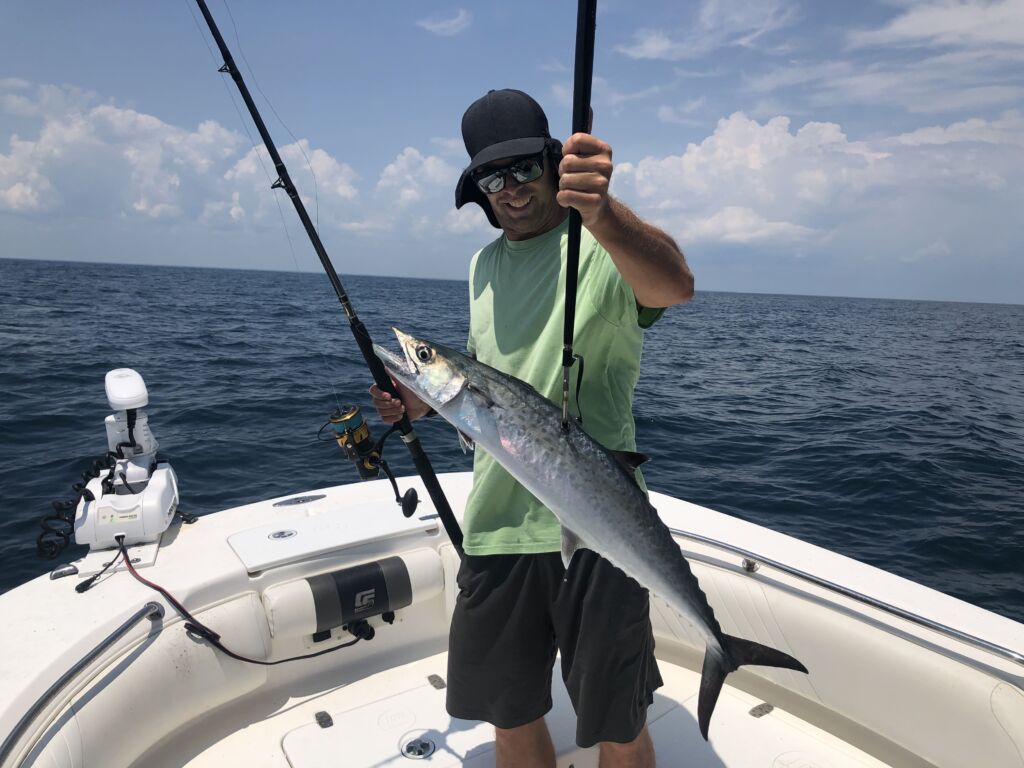
Spreads/Depth: Your spreads and the depths of your baits are going to play a huge part in the success of your day on the water. First, let’s talk about spreads. You want as many lines out as possible without them getting easily tangled—4 is a good number to shoot for. Stagger these lines short to long making sure none are the same distance back as another (keep in mind this applies for live, dead, and artificial baits). Remember to also try and vary the baits if you have the resources to do so. Put 1 bluefish and 3 live pogies out or some combination until you figure out what the fish want. Feel free to put skirts on some of the baits and troll others naked. The point is: to mix up your tactics until you figure the fish out. This goes for artificials and dead bait too. Don’t use four of the same lures—mix it up. Try Ballyhoo and Cigar Minnows for dead bait. Don’t put all your eggs in one basket. For depth, this is going to apply to live and dead bait and whether or not you have the resources to do so. If you have the luxury of downriggers, then by all means use them on at least one bait to get it down to a lower depth (remember to stagger the depths of your baits if you have more than one downrigger). Keep in mind that most King Mackerel bite on the surface though. In all my hours of King Mackerel fishing, I’ve only ever had one king bite far down in the water. I like to keep my baits on the surface, and this tends to work out well most of the time. The reality is, the deeper you go with natural baits, especially dead ones, the more likely you are to pick up sharks that you don’t want to deal with.
Casting/Trolling/Bottom Fishing: While these three methods are all viable options for catching King Mackerel, I’m going to focus on trolling because it is by far the most popular. A quick note, however: You’re very rarely going to catch a King bottom fishing so don’t target them that way. If you have caught one like that, then it was likely just bycatch. Also, if you’re lucky enough to have Kings on the surface to cast to, you can throw anything at them if they’re fired up (live baits work especially well though). Anyway, a few quick notes on trolling. When live bait trolling, you want to be going very, very, very slow. Your boat should barely be in gear so that your baits don’t drown. If you’re trolling dead baits, stay at a speed where your baits won’t spin and look natural; this can be anywhere between 3 and 7 mph. For artificials you can go a little faster, but the important thing is to look at how the bait behaves at that speed, if it looks unnatural, speed up or slow down accordingly.
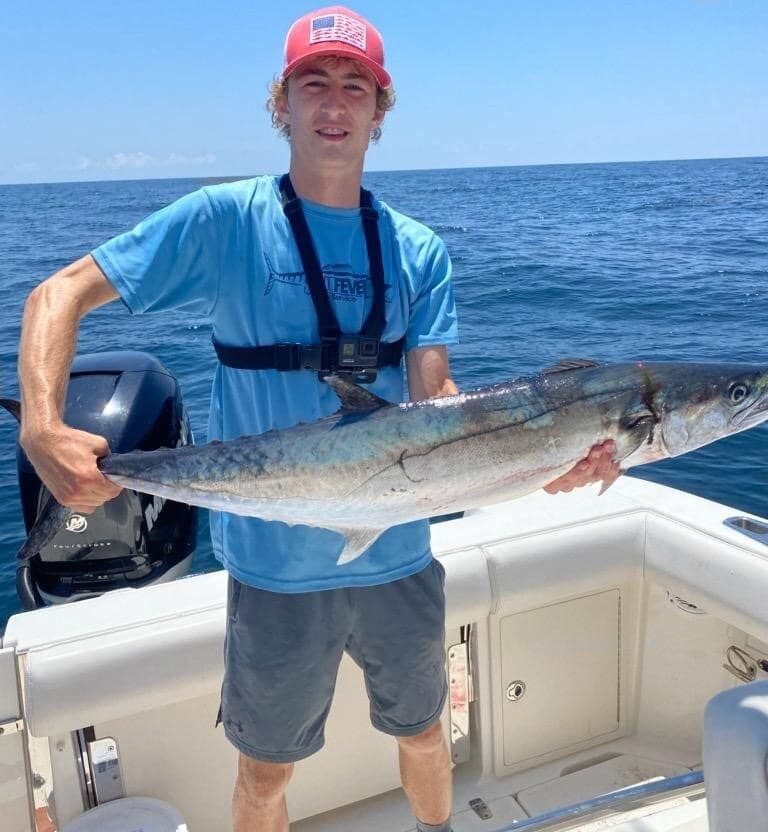
King Mackerel Fishing: Prime Locations, Ideal Conditions, and Optimal Times of the Year
- Time of year: Peak season for King Mackerel fishing, especially on the East Coast, is in the Fall in October and November. Spring and Summer are also decent, but the class and numbers just aren’t comparable to the fall. Winter is very tricky for Kings on the East Coast which is why we don’t do it much when it gets cold here. However, in the Gulf and warmer waters, you can catch King Mackerel pretty much year-round.
- Water depth: Water depth for Kings is going to be very different and every angler will tell you something different depending on where they normally fish and what time of year it is. For us, in the Spring and Fall, most Kings are caught in 40 feet of water or less. However, as the water heats up in the Summer, fish push off into the 50s, 60s, and even 70s at times. If you’re unsure of the depth you should be fishing, talk to some of your locals and they’d be happy to give you some tips on where to start fishing.
- Structure: Rock piles, ledges, drop offs and reefs are where most of these King Mackerel are going to congregate. They need a place where bait is going to be and will hang around there. If you’re ever driving around in an area that has bait held tight to some structure on the bottom, then be on the lookout because Kings will likely be around.
- Weather: Because King Mackerel fishing is primarily trolling-based, weather plays a huge influence on the bite. When it’s rough or windy, it makes it very difficult to keep lines straight and baits look normal in the water. After a big storm with rain, you will also likely have a harder time finding fish because of the water clarity. Preferably, you want very little waves with sun and a little wind so the fish can’t see the surface as easily.
Read also: Unlocking the Secrets of Perfect Fishing Weather: Best Conditions for a Great Catch
A Typical Day King Mackerel Fishing
This section of the article is something new I’ve thought of recently and think it will greatly help anglers get an idea of what a day of King Mackerel fishing could look like for them from my point of view. The goal of this is to describe what my typical day would look like If I were King Mackerel fishing so you can tweak this plan and then use it if you want to. T
he day starts early—around 5 or 6 in the morning. If I have any live bait from the bait tank on the dock, I’ll go ahead and throw it in the live well (this is bait generally left over from another trip or caught the night before in the canals). I load up all our gear, including a 5-pound box of frozen cigar minnows or ballyhoos and head out. Immediately, whether we have bait in the tank or not, we will look for fresh baits. We head out of the inlet and look close to shore for pogies flicking their tails on the surface of the water. After cast netting around 50-75 baits, we’ll head offshore to our predetermined spots planned the night before (it is very important to have a game plan already in place).
As soon as we get there, I’ll get right to putting the lines out. Because I’m usually King Mackerel fishing from a relatively small boat, I’ll normally setup a spread of three rods. One short surface rod, one medium surface rod and one long surface rod making sure the long and medium rods are on opposite sides of the boat. First, I put out the long rod and used a two-treble hook rig with a live pogy for bait. I’ll drop this rod about 120-150 yards behind the boat slowly feeding out the line. At this point, the boat is either barely in gear or moving under the power of the trolling motor. I’ll do the same thing for the medium and short rod except I drop the medium rod about 60-80 yards behind the boat and the short rod about 25-30 yards behind the boat. Yes, I know 25 yards sounds very short, but the second most popular bite spot from my own experience was right in the prop wash. Also, keep in mind this is my setup on a normal day.
If we get lucky and find a bluefish, I’m sticking him on the far rod. However, if it’s a day without any live bait, I’m using Mac-A-Hoos with Cigar Minnows in the same spread. Now, it’s just a waiting game. I’ll normally stay at a spot for about 45 minutes to an hour and if there is no action I’ll pick up and do the same thing at a different spot.
Get your personalized fishing map
Answer a quick quiz and get your own personalized fishing map
Conclusion
I hope this article provides you with everything you need to take on King Mackerel in your local waters. I know some people think that they are trash fish but try fighting one and then get back to me once you’ve given them a chance. If you have any questions or concerns, please comment on the article and I will get back to you ASAP. Tight Lines!
Photo Source: All photos in this article were provided by expert Pierce Latta.
Visit his Instagram profile.
Subscribe to his YouTube channel.
